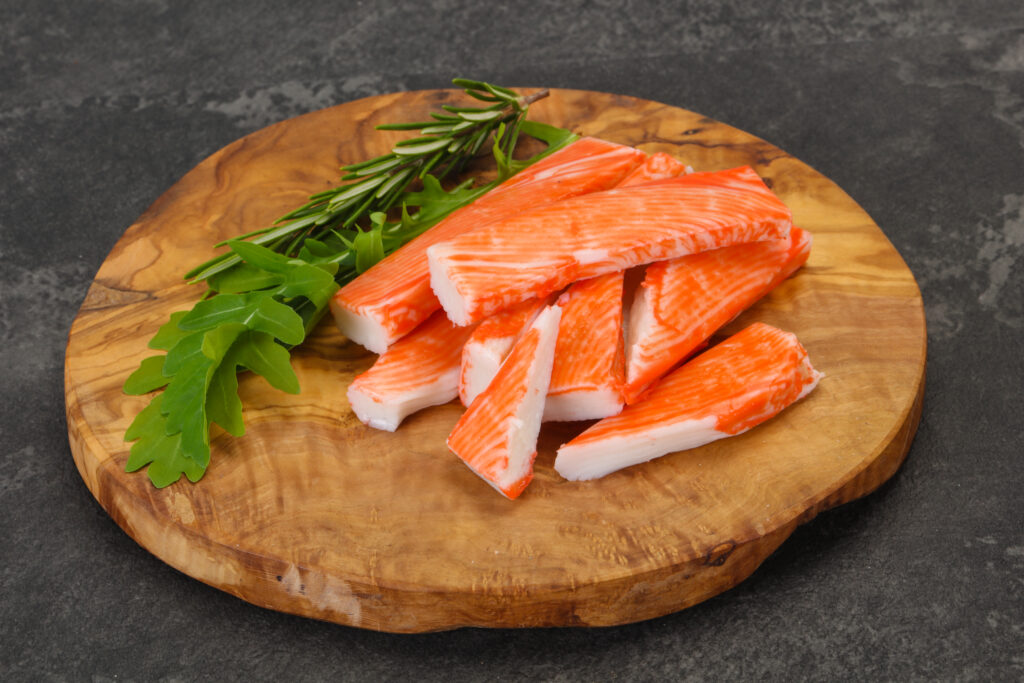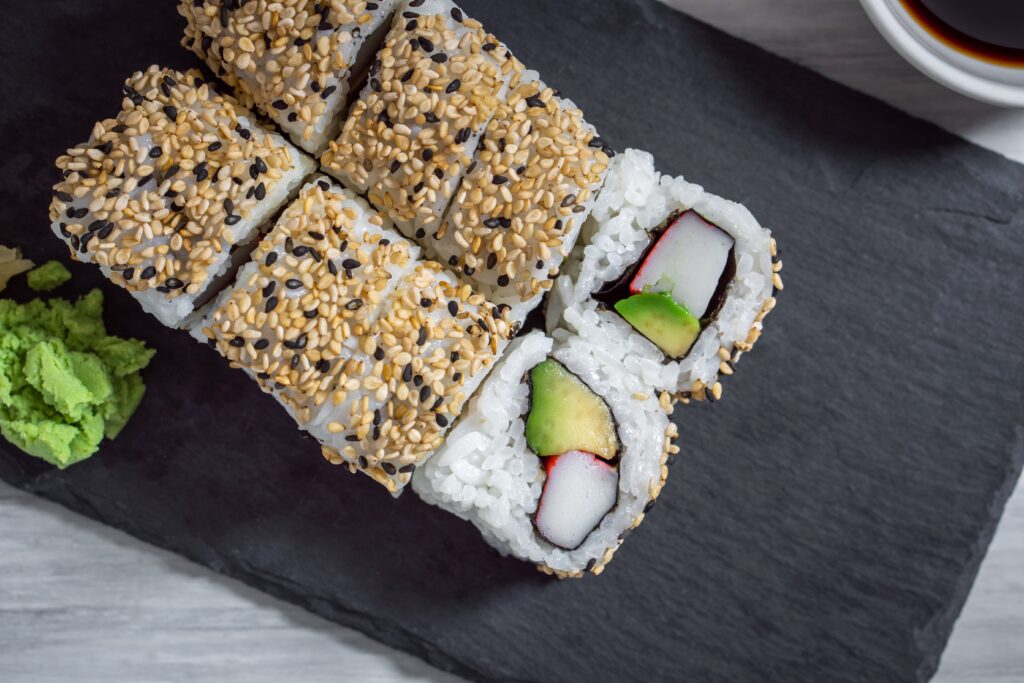
Surimi (meaning “ground meat” in Japanese) is a processed seafood product made from fish. Also called seafood highlighter or seafood extender, surimi is often used as a crab meat substitute in sushi rolls and crab sticks, as well as an ingredient in seafood salads, fish balls and other dishes.
Surimi was invented in Japan in the 12th century as a way of preserving leftover fish catch. In the 1970s, production expanded beyond Japan to become a global industry worth several billion dollars annually (1). In Australia, it is available in supermarkets and is sold frozen or thawed.
What is surimi made of?
Despite its popular use as imitation crab, surimi is actually made from fish. Depending on where it’s produced, it may also contain squid, chicken or goat (2).
Surimi was traditionally made from Alaskan pollock, whiting and hake. As production has expanded beyond the northern Pacific, surimi is increasingly made from tropical demersal (bottom dwelling) species like threadfin breams, snappers, groupers, croakers, lizardfish and others (3). Farmed fish like carp and catfish are being explored for surimi production in China and Vietnam, respectively.
To make surimi, the fish are deboned, washed and blended up into a paste. Colour, flavourings and other processing agents are added, then the mixture is heated and pressed into shape. Surimi can be served on its own, or mixed in with other ingredients. Premium surimi is white with artificial red colouring on top, while lower-grade surimi has a grey or brown tint.
You can get a glimpse of this process below through this YouTube video. AMCS has no connections to this video or it’s production.
Where is it made?
Today, around 70% of the world’s surimi is made from tropical species caught in Southeast Asia (4). In 2020, this production was estimated at around 650,000 tonnes. The major producers are China (230,000 tonnes), Vietnam (180,000 tonnes), India (110,000 tonnes), Thailand (60,000 tonnes), Indonesia (30,000 tonnes), Malaysia (20,000 tonnes), Pakistan (5,000 tonnes) and Myanmar (2,000 tonnes) (5).
Production of surimi made from pollock and other ‘cold water’ species occurs in China, the United States, Japan, and South America, but at a much smaller scale.
Australia imports surimi from China, Thailand, India, Vietnam and other countries.

Is surimi sustainable?
It all depends on what type of fish the surimi is made of.
Alaskan pollock was historically one of the most preferred species for surimi, and it remains popular today. The US Alaskan pollock fishery is carefully managed and is considered sustainable (6). Unfortunately, fraud and mislabelling are common in the surimi industry, with low-value species being substituted and sold as more valuable ones (7). In one study, 84% of surimi products claiming to contain Alaskan pollock were instead made of other species (8).
Weaker fisheries management in some Asian and Southeast Asian countries means that surimi produced from those fish stocks may not be sustainable, and may be incentivising continued exploitation of vulnerable stocks. Additionally, surimi is often made using ‘trash fish’ that are caught in non-selective trawl fisheries, including juvenile fish. These fishing methods can put pressure on fish stocks and have consequences for population decline and ecosystem health.
In short, unless your surimi has detailed labelling and effective traceability, we’d avoid it and choose from the surimi alternatives listed below.
What other issues does surimi have?
Because surimi is highly processed, it is impossible to know what’s in it without conducting scientific tests. Unfortunately, the label might not tell the full story.
Studies of surimi sold overseas have found products containing DNA from endangered species, such as rhino rays (9) and striped catfish (10). Surimi production occasionally uses products from non-fish animals, such as squid, chickens or goats, to create a firmer texture. When this is not disclosed on the label, consumers with religious dietary restrictions (11) or allergies (12) are not able to make informed choices.
Accurate labelling is important in order to evaluate sustainability, but also to alert consumers to the potential presence of allergens or other unwanted ingredients in their food.
What can I use instead of surimi?
Fortunately, there are lots of alternatives to surimi. If you’re after seafood, check out the GoodFish Guide’s recommendations for sustainable Australian crab choices: https://goodfish.org.au/surimiswaps.
For those who prefer to avoid meat, some plant-based options are mushrooms (enoki, lion’s mane, oyster), jackfruit and artichoke hearts.
References
- Park, J.W., 2005. Surimi and surimi seafood. CRC press.
- Aravindran, S., Sahilah, A.M. and Aminah, A., 2014, September. Market surveillance on non-halal additives incorporated in surimi based products using polymerase chain reaction (PCR)-southern hybridization analysis. In AIP Conference Proceedings (Vol. 1614, No. 1, pp. 202-207). American Institute of Physics.
- Leadbitter et al. (2020). The production of surimi and surimi seafood from tropical fish – a landscape view of the industry Report to the Certification and Rating Collaboration. December 2020. Available at: https://certificationandratings.org/wp-content/uploads/2023/04/Surimi-Landscape-Report-Final-2.pdf
- Leadbitter et al. (2020). The production of surimi and surimi seafood from tropical fish – a landscape view of the industry Report to the Certification and Rating Collaboration. December 2020. Available at: https://certificationandratings.org/wp-content/uploads/2023/04/Surimi-Landscape-Report-Final-2.pdf
- Leadbitter et al. (2020). The production of surimi and surimi seafood from tropical fish – a landscape view of the industry Report to the Certification and Rating Collaboration. December 2020. Available at: https://certificationandratings.org/wp-content/uploads/2023/04/Surimi-Landscape-Report-Final-2.pdf
- https://www.seafoodwatch.org/recommendations/download-consumer-guides/sustainable-pollock-guide
- Detcharoen, M., Khrueakaew, P., Sukkapat, P., Benjakul, S. and Saetang, J., 2024. Metabarcoding for authentication of fish species in surimi-based products by Nanopore sequencing. Food Bioscience, 61, p.104628.
- Pepe, T., Trotta, M., Di Marco, I., Anastasio, A., Bautista, J.M. and Cortesi, M.L., 2007. Fish species identification in surimi-based products. Journal of agricultural and food chemistry, 55(9), pp.3681-3685.
- Galal-Khallaf et al. (2016) Towards more sustainable surimi? PCR-cloning approach for DNA barcoding reveals the use of species of low trophic level and aquaculture in Asian surimi. Food Control, 61, pp.62-69.
- Detcharoen, M., Khrueakaew, P., Sukkapat, P., Benjakul, S. and Saetang, J., 2024. Metabarcoding for authentication of fish species in surimi-based products by Nanopore sequencing. Food Bioscience, 61, p.104628
- Aravindran, S., Sahilah, A.M. and Aminah, A., 2014, September. Market surveillance on non-halal additives incorporated in surimi based products using polymerase chain reaction (PCR)-southern hybridization analysis. In AIP Conference Proceedings (Vol. 1614, No. 1, pp. 202-207). American Institute of Physics.
- Giusti, A., Armani, A. and Sotelo, C.G., 2017. Advances in the analysis of complex food matrices: Species identification in surimi-based products using Next Generation Sequencing technologies. PloS one, 12(10), p.e0185586.